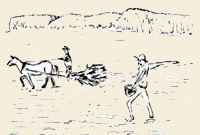
Spring 2005

 |
|
 |
| Home | Index | Museums | Blog | Authors | Site Map | About |
|
About this IssueNote from the EditorsSix installments of Elizabeth Shanklin's "Authorizing Mothers: A Study of the First Maternal Association, Utica, New York, 1824 - 1833," starting in issue #129, have appeared in the Crooked Lake Review. The concluding seventh part begins this issue. Ms. Shanklin has described the occupations and culture in early Utica and the connections between the prominent families, most of whom were members of the First Presbyterian Church. She has told in detail the events leading to the formation of the Maternal Association and how the wives of the prosperous Utica men came to replace the child-rearing practices demanded by the Calvinist clergy, that parents destroy their infant children's awareness of self, with their own motherly nurturing of children. These mothers freed their children from self-loathing by maternal good sense, discussion, reading, and support of each other. In this final installment Ms. Shanklin describes how many Utica mothers continued to ignore the harsh Abrahamic Covenant precepts and began publishing a magazine on mothering. Elizabeth Shanklin has "made it her life's work to understand and contribute to the elimination of social structures that lead to and perpetuate destructive human behavior…." She has contributed to several books on mothering and has presented papers at women's conferences in Canada, at Fordham University, the University of Rochester, and the City University of New York Graduate Center. She presently teaches in New York City. The second and concluding part of Wayne Mahood's story of Morris Brown continues to relate the Penn Yan soldier's experiences and feelings through the confusion, the rivalries, the horrible battles of the Civil War. Brown tells it all in letters home to his parents and sister and to his brother also in the army: the waiting, the wearying marches, the ferocious fights, the loss of comrades, the compassion for the confederate line men, and the realization of doom. Morris Brown, Jr., capable, always seeking command advancement, daring, lucky soldier through many encounters, is suddenly killed outright during a nightime attack on Petersburg. In his letters he wrote of returning to Penn Yan as commander with a few survivors of the 126th New York Volunteers, all of them covered with glory; Morris Brown's body was never found. Wayne Mahood has written several books on the Civil War. Thomas D. Cornell's Genesee Vignettes series continues in this issue with his essay about the Mount Morris Dam. The dam is located at the north end of Letchworth Park, and was built to protect Rochester from flooding by the Genesee River. It also increases the capacity of the hydro-electric dam downstream by saving the runoff waters for power generation. In a following essay he writes of his childhood memories of the park. Included are Tom's photographs of the dam site and a picture taken by his parents in the 1950s of Tom feeding raccoons on a cabin porch at the park. Tom Cornell has contributed many essays to the CLR—most recently The Call of Stories in issues #123 and #124. Donovan Shilling writes of H. H. Warner's entrepreneurial success concocting and promoting patent medicines. He was a marketer who anticipated what people wanted: relief from aches and pains, self indulgence for their everyday complaints, alcohol with another name, and an excuse to join the great consuming crowd. As Don says, Warner was a genius for using one symbol to convey another meaning, the image of an office safe on a bottle to suggest the safeness of the liguid contents. It was fun and profitable until he found himself over-extended in a business panic. H. H. moved out of town and continued in the sure-fire business of selling medicines, although more modestly. Don Shilling has contributed many stories and reports of visits to historical sites by the New Society of the Genesee. His most recent article How Did They Ever Come Up With That Name? was in issue #132. John Sheret, continuing his Mendon—The Early Years series, relates the history of general stores in Mendon Centre which was a busy community at the intersrection of the road from Honeoye Falls to Pittsford and the road from Victor to Rush. Robert Briggs established a general store there at the early 1800s, then bought a newer building nearby and later sold out to Albert Alonzo Gazley who later built a larger building with a social hall above. General stores were the center of business and social life in rural communities. House wives came for supplies and brought eggs or butter to trade, people came to get their mail or send letters—post offices were often located in general stores. When there was a performance hall above on an upper floor they came for entertainment, as did the retired farmers who congregated at the store for socializing. Sometimes the store owner was a justice of the peace or otherwise arbited differences. Store keepers often operated wagons over regular routes to deliver goods to farms. Both the Gazley family and later Oliver Frances carried groceries and supplies to farm families. Ollie Frances died in 1949 and the store finally closed in 1953. John wrote about the Dibble Seed House in the last issue. There are more of his stories to come. Timothy Meigs Younglove's diary entries of April and May 1841 tell us what concerned him 164 years ago on his farm in Pleasant Valley, Urbana Town, Steuben County, New York. He recorded the thermometer reading for nearly everyday. Was the temperature going to warm enough for the grass to grow before he ran out of hay for his livestock? Finally in May the weather did start the grass. In early April they were busy preparing the ewes for lambing by shearing around their udders (tagging) so newborn lambs could quickly find nourishment without hanks of wool hiding the teats. While the lambs are arriving TM keeps count of the survivors and losers—important for his future flock size. Later in May they wash the sheep to be ready to shear fleeces. There are other farm activities: some of the help are spreading lime (plaster) on the fields to neutralize acid soil, and all this time they are getting out logs and hewing beams for a barn frame. TM is busy with his sideline surveying business and with collecting and lending money, and with lawing—requesting a summons to collect payment, consulting lawyers about an estate, attending court, appearing as a witness. He follows national politics, too. The Younglove family diaries have been transcribed and saved by their descendant, Leonard Paul Wood who lives in Pleasant Valley. Year 1828 from David Minor's Eagles Byte New York Timeline begins now with three installments and will continue in future issues. David is following James Stuart and his party's travels in New York State. They leave sweltering New York City in late August and go up the Hudson to Albany in the steam-powered North America carrying 900 passengers. Stuart records much of what he sees including menus and too many spit boxes in public buildings. After a couple of days in Albany they travel by stage to Schenectady then ride on a canal boat to Utica. Along the way David keeps us up on New York personalities Amos Eaton and Erastus Corning and national and local events. Don't forget to view the various websites with additional information on places along the route. Richrd Palmer writes about the Cherry Valley Turnpike, a name for the three sections of the Great Western Turnpike that extended west from Albany through Cherry Valley and on to Cazenovia. The name came to include the route on west to Skaneateles which was never a turnpike and eventually Route 20 to Manlius and Auburn. The Third Great Western Turnpike was authorized in 1803 and the last of the gate houses completed in 1810. It was a heavily-used route by freight haulers until the Erie Canal opened but it continued to be a stage route because it was shorter and it was favored by drovers until railroads began hauling livestock in the 1840s. The turnpike didn't close until 1857 and it still remains a popular scenic route for automobiles. Dick Palmer lives in Syracuse and writes about railroads and all forms of transportation. Activities, accidents, and accomplishments in and around Naples for the months of April and May in 1905 and 50 years later in 1955 have been selected by Beth Flory from the Naples Record of those years for her "Glancing Backward" column that appears regularly in the current Naples Record and here, too. Beth has written stories of her mother and grandfather and her family's long-time connections with Naples. She is president of the Naples Historical Society and lives in a Canadaigua Lake cottage formerly owned by her grandfather and then her mother. We welcome your comments and suggestions. Pleasant reading, Martha and Bill Treichler CLR Blog | Site Map | Contact CLR |